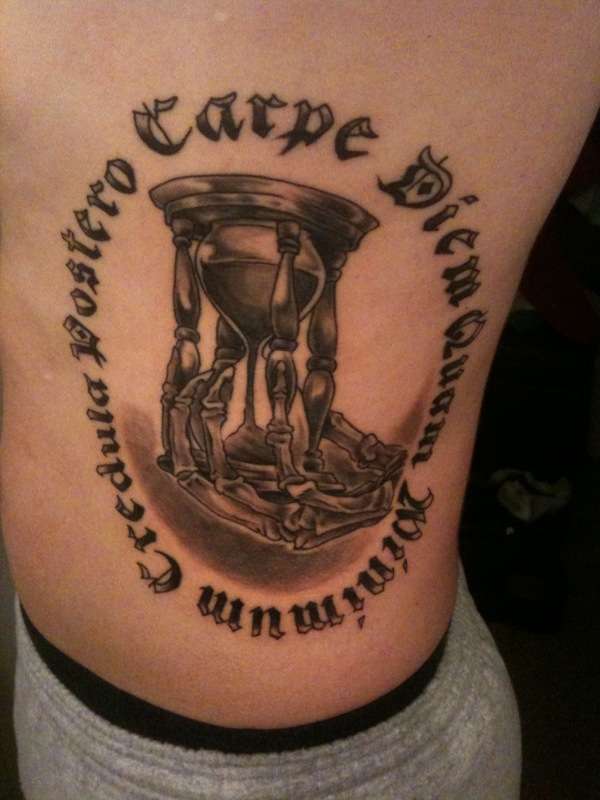
Hacia otro mundo Carpe diem quam minimum credula postero
The Editors of Encyclopaedia Britannica. The Roman poet Horace used the phrase carpe diem to express the idea that one should enjoy life while one can. It is part of Horace's injunction "carpe diem quam minimum credula postero" (translation: "pluck the day, trusting as little as possible in the next one"), which appears in his Odes (23 BCE).

Carpe Diem quam minimum credula postero Post by vaneives on Boldomatic
Articles. "Carpe diem (quam minimum credula postero)". Lire en ligne. « Cueille le jour présent (sans te soucier du lendemain) », dixit Horace, poète né à Venosa en 65 av. J.-C. (Jésus.

Carpe Diem Quam Minimum Credula Postero. Seize the day, put very little trust in tomorrow (the
carpe diem: [noun] the enjoyment of the pleasures of the moment without concern for the future.

Carpe Diem Quam Minimum Credula Postero. Seize the Day Put Etsy
view quotes. Apr 03, 2016 12:38AM. tmrygt. 3 books. view quotes. May 19, 2015 02:30PM. Horace — 'Carpe diem, quam minimum credula postero. (Pluck the day [for it is ripe], trusting as little as possible in tomorrow.)'.

Carpe Diem Quam Minimum Credula Postero. Seize the Day Put Etsy Carpe diem, Inspirational
Carpe diem, quam minimum credula postero, es una frase en latín que significa 'aproveche el día de hoy y confíe lo mínimo posible en el mañana'.La frase fue escrita por Quinto Horacio Flaco (65 a.C. - 8 a.C.) poeta y filósofo de Roma antigua, en el libro 'Odas', una de las obras más importantes de la literatura universal.. Algunos aspectos del epicureismo se destacan en su.

Rêves d'un ange Carpe Diem quam minimum credula postero
Oli's lesson. One of my best friends, Oli, felt so passionately about this omission, that he wanted to get "quam minimum credula postero" tattooed on his body.He died before he ever got the.

Horacio. Carpe diem quam minimum credula postero. Aprovecha cada día, no te fíes del mañana
carpe diem: Odes 1.11. Horace's Carpe diem consists of an invitation for the reader to appreciate the day in all its facets, in every moment, without thinking about tomorrow. It is the most famous of Horace's odes. It has the tone of a conversation happening in front of a stormy sea, the dialogue is between a mature man, made wise by age.

Carpe diem quam minimum credula postero lokasinoh
The phrase "in that way", "illa", in the line "Let us shake the abacus in that way", is in anaphoric co-reference with the preceding six utterances of "Give me.". In other words, exchanging those countless kisses is the way to consummating their love. "Illa" here is called a presupposing expression.
Carpe Diem, quam minimum credula postero
Carpe diem is a phrase taken from the Latin used by the poet Horace. The entire phrase is Carpe diem quam minimum credula postero, "Seize the day, trusting as little as possible to the future.

"Carpe Diem quam minimum credula postero" Carpe Diem, Manama, Just Me, Infinity Tattoo, Tattoo
Quotations : "Carpe diem, quam minimum credula postero.". — Horace, Odes Book I. The full quotation is carpe diem, quam minimum credula postero, which translates to something like "harvest the day and put little trust in tomorrow.". The common translation is "seize the day" and it implies an active assumption of control over our.

Carpe diem quam minimum credula postero
Horace: Odes I. I. Maecenas atavis edite regibus, o et praesidium et dulce decus meum, sunt quos curriculo pulverem Olympicum. collegisse iuvat metaque fervidis. evitata rotis palmaque nobilis 5. terrarum dominos evehit ad deos; hunc, si mobilium turba Quiritium.

Carpe Diem Quam Minimum Credula Postero. Seize the Day Put Etsy
Translation. Carpe is the second-person singular present active imperative of carpō "pick or pluck" used by Horace to mean "enjoy, seize, use, make use of". Diem is the accusative of dies "day". A more literal translation of carpe diem would thus be "pluck the day [as it is ripe]"—that is, enjoy the moment. It has been argued by various authors that this interpretation is closer to Horace's.

Carpe diem quam minimum credula postero Post by sirskitten1 on Boldomatic
Explanation: Gather ye rosebuds while ye may.-----Note added at 2003-01-29 06:13:41 (GMT)-----Horace, Odes Book I, No. XI The most famous of Horace\'s odes uses agricultural metaphors to urge us to embrace the pleasures available in everyday life instead of relying on remote aspirations for the future - hence his immortal motto \"Carpe Diem\", or \"pluck the day\": Tu ne quaesieris - scire.

Carpe Diem Quam Minimum Credula Postero. Seize the Day Put Etsy
In the phrase "carpe diem, quam minimum credula postero", why "minimum" is singular neuter? I mean, if it means "there are least trustable things in the future", wouldn't it be "quam minima credula"?

Carpe diem quam minimum credula postero
La frase completa di cui fa parte questa locuzione latina è "Carpe diem quam minimum credula postero", tratta dalle Odi di Orazio, risalenti al 30 a.C, che comprendono 104 poesie, raccolte in quattro volumi. La sua traduzione è: "Cogli il giorno, confidando il meno possibile nel domani. Il giorno, in questa frase va inteso come presente.

Carpe Diem Quam Minimum Credula Postero tattoo
This Latin phrase appears in a poem by written by Horace in Odes Book I, where it reads as, "Sapias, vina liques et spatio brevi Dum loquimur, fugerit invida Aetas: carpe diem, quam minimum credula postero." (Odes, 1.11)It implies that one should make the most of his present moment, and grab hold of the chances he gets for happiness as soon as they appear, before they disappear, because.
- Qual O Nome Verdadeiro De Deus
- A Origem Da Língua Espanhola
- Qual é A Música Representativa Do Brasil
- O Desaparecimento De Sidney Hall
- 5 Mil Reais Em Dolar
- Quem é O Pai Do Diogo Nogueira
- Fear The Walking Dead Tem Quantas Temporadas
- Nome Das Teclas Do Teclado Do Notebook
- Estudo Sobre O Livro Do Apocalípse
- Sete Desafios Para Ser Rei Pdf